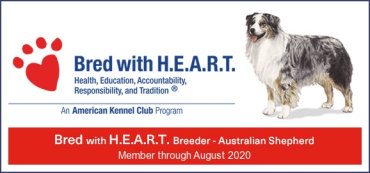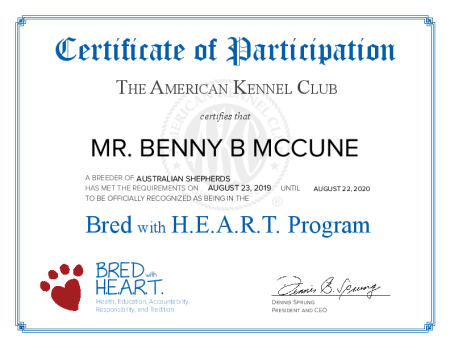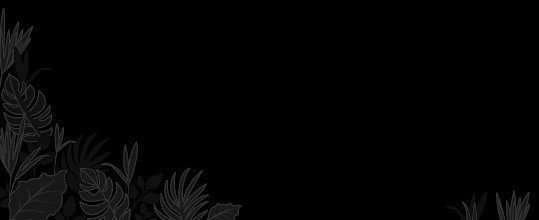

HONEYCREEKAUSSIES.COM
Australian Shepherds - The Breed that Works.
Honeycreek Australian Shepherds
We Love Our Friends
Aussie's - Loyal, Playful, Loving
The Family Welcomes You To Our World

Official Standard of the Australian Shepherd
American Kennel Club - AKC - Standards of a Australian Shepherd.
What the AKC people will accept as a TRUE Australian Shepherd.
I have gone over this in another section but wanted to make it as clear as possible to all interested in a Australian Shepherd as their new friend. It may not matter to some about the types of registrations for your new friend but it will to others so that is why I am so adamant about this. Toy, Miniature or any other wording used for a Australian Shepherd is not let me repeat and stress IS NOT registrable by the AKC, they are NOT recognized by them as a Australian Shepherd breed at this time. What does this mean? Nothing if you do not plan to breed, show or run agility trails by AKC standards or AKC points. If your Australian Shepherd is registered by ANYONE other than the Official AKC people you will NOT be able to participate in ANY AKC sponsored event EVER.
So I beg of you watch who you purchase the breed from, ASK for their proof of AKC registration and if they have it a DNA (some do, some do not) record as well as the a lineage of the parents to assure no cross breeding or Merle to Merle breeding. Any reputable breeder will have this information and be very glad to give a copy and/or at least let you see it. The old saying plays very true when purchasing any breed, "Buyer Beware".
This knowledge and awareness is for your sake as well as the well being of the Australian Shepherd breed but applies to any breed. Do you homework prior to purchasing any breed. Make sure 1 it is the breed for you and 2 that the breeder is of good standing and has the breed of question in their heart not their pocket book.
General Appearance:
The Australian Shepherd is an intelligent working dog of strong herding and guarding instincts. He is a loyal companion and has the stamina to work all day. He is well balanced, slightly longer than tall, of medium size and bone, with coloring that offers variety and individuality. He is attentive and animated, lithe and agile, solid and muscular without cloudiness. He has a coat of moderate length and coarseness. He has a docked or natural bobbed tail.
Size, Proportion, Substance:
The preferred height for males is 20 to 23 inches, females 18 to 21 inches. Quality is not to be sacrificed in favor of size. Proportion - Measuring from the breastbone to rear of thigh and from top of the withers to the ground the Australian Shepherd is slightly longer than tall. Substance - Solidly built with moderate bone. Structure in the male reflects masculinity without coarseness. Bitches appear feminine without being slight of bone.
Head:
The head is clean cut, strong and dry. Overall size should be in proportion to the body. The muzzle is equal in length or slightly shorter than the back skull. Viewed from the side the top line of the back skull and muzzle form parallel planes, divided by a moderate, well-defined stop. The muzzle tapers little from base to nose and is rounded at the tip.
Expression -
Showing attentiveness and intelligence, alert and eager. Gaze should be keen but friendly. Eyes are brown, blue, amber or any variation or combination thereof, including flecks and marbling. Almond shaped, not protruding nor sunken. The blue Merle's and blacks have black pigmentation on eye rims. The red Merle's and reds have liver (brown) pigmentation on eye rims. Ears are triangular, of moderate size and leather, set high on the head. At full attention they break forward and over, or to the side as a rose ear. Prick ears and hanging ears are severe faults.
Skull -
Top flat to slightly domed. It may show a slight occipital protuberance. Length and width are equal. Moderate well-defined stop. Muzzle tapers little from base to nose and is rounded at the tip. Nose - Blue Merle's and blacks have black pigmentation on the nose (and lips). Red Merle's and reds have liver (brown) pigmentation on the nose (and lips). On the Merle's it is permissible to have small pink spots; however, they should not exceed 25 percent of the nose on dogs over one year of age, which is a serious fault. Teeth - A full complement of strong white teeth should meet in a scissors bite or may meet in a level bite.
Disqualifications -
Undershot. Overshot greater than ? inch. Loss of contact caused by short center incisors in an otherwise correct bite shall not be judged undershot. Teeth broken or missing by accident shall not be penalized. Neck, Top line, Body: Neck is strong, of moderate length, slightly arched at the crest, fitting well into the shoulders.
Top line -
Back is straight and strong, level and firm from withers to hip joints. The croup is moderately sloped. Body - Chest is not broad but is deep with the lowest point reaching the elbow. The ribs are well sprung and long, neither barrel chested nor slab-sided. The underline shows a moderate tuck-up. Tail is straight, docked or naturally bobbed, not to exceed four inches in length.
Forequarters:
Shoulders - Shoulder blades are long, flat, fairly close set at the withers and well laid back. The upper arm, which should be relatively the same length as the shoulder blade, attaches at an approximate right angle to the shoulder line with forelegs dropping straight, perpendicular to the ground. Legs straight and strong. Bone is strong, oval rather than round. Pastern is medium length and very slightly sloped. Front dewclaw's may be removed. Feet are oval, compact with close knit, well arched toes. Pads are thick and resilient.
Hindquarters:
The width of the hindquarters is equal to the width of the forequarters at the shoulders. The angulation of the pelvis and upper thigh corresponds to the angulation of the shoulder blade and upper arm, forming an approximate right angle. Stifles are clearly defined, hock joints moderately bent. The hocks are short, perpendicular to the ground and parallel to each other when viewed from the rear. Rear dewclaw's must be removed. Feet are oval, compact with close knit, well arched toes. Pads are thick and resilient.
Coat:
Hair is of medium texture, straight to wavy, weather resistant and of medium length. The undercoat varies in quantity with variations in climate. Hair is short and smooth on the head, ears, front of forelegs and below the hocks. Backs of forelegs and britches are moderately feathered. There is a moderate mane and frill, more pronounced in dogs than in bitches. Non-typical coats are severe faults.
Color:
Blue merle, black, red merle, red-all with or without white markings and/or tan (copper) points, with no order of preference. The hairline of a white collar does not exceed the point of the withers at the skin. White is acceptable on the neck (either in part or as a full collar), chest, legs, muzzle underpart's, blaze on head and white extension from underpart up to four inches, measuring from a horizontal line at the elbow. White on the head should not predominate, and the eyes must be fully surrounded by color and pigment. Merle's characteristically become darker with increasing age. Disqualifications - White body splashes, which means white on body between withers and tail, on sides between elbows and back of hindquarters in all colors.
Gait:
The Australian Shepherd has a smooth, free and easy gait. He exhibits great agility of movement with a well-balanced, ground covering stride. Fore and hind legs move straight and parallel with the center line of the body. As speed increases, the feet (front and rear) converge toward the center line of gravity of the dog while the back remains firm and level. The Australian Shepherd must be agile and able to change direction or alter gait instantly.
Temperament:
The Australian Shepherd is an intelligent, active dog with an even disposition; he is good natured, seldom quarrelsome. He may be somewhat reserved in initial meetings.
Faults -
Any display of shyness, fear or aggression is to be severely penalized.
Disqualifications:
Undershot. Overshot greater than one eighth of an inch. White body splashes, which means white on body between withers and tail, on sides between elbows and back of hindquarters in all colors.
Copied from the AKC site directly at AKC Standards Australian Shepherd, all credits for the above article giving to AKC.Org in it's entirety.
Approved May 14, 1991 Effective January 1, 1993


